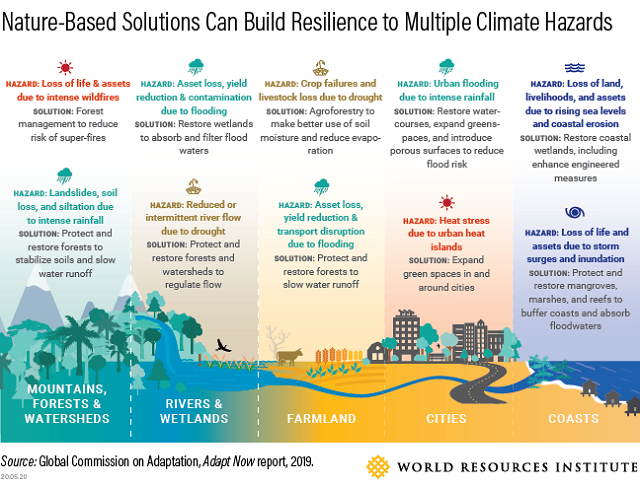If Nature has the ability to bedevil our path with problems, it is surely one of the resources we can look forward to, for solving our problems.
And hence, Nature-based Solutions have been intrinsic to the COP 26.
As per IUCN, these are “actions to protect, sustainably manage, and restore natural or modified ecosystems”, such that it helps balance societal challenges effectively while providing benefits to human well-being and the biodiversity.
“We know that nature has a key role to play in meeting climate change targets and adapting to climate change, but this was not formally outlined in the Paris Agreement”, explains the World Wildlife Fund (WWF).
Why this is important? Nature is an integrated mesh of broad range of Ecosystems: coastal, tundra, mountainous, freshwater etc. None of these, is safe from facing the impacts of Climate change.
Major changes like biodiversity loss, productivity decline etc., attributed to climate change need to be addressed collectively as interwoven challenges, and will require finance to be drawn towards high-quality nature-based solutions.
These can surely help in achieving our targets under the Paris Agreement as they have the potential to offer up to 30 percent of the climate change mitigation needs and limit the global temperatures to 1.5 degrees
Aiding to fulfil the Sustainable development, they could even be made to generate trillions of dollars in benefits.
One of such solutions has been the recent focus on Integrated Management farms, the technique that complements traditional cropping methods with farming vegetables and fruits, sustaining poultry or fishery alongside.
Therefore, ICAR conducted research to ascertain the comparative advantages of the ‘whole-farm’ approach in the North-East, where fragility comes at its peak while inundation.
The study undertook 11 farm pond-based IFS (Integrated Framing system) models worked over by 150 farmers, spanning over 22.5 hectares in the South Garo Hills district of Meghalaya, for a period of 5 years i.e., 2009 to 2014.
It was only to find out that farmer’s incomes and farm’s productivity can be “improved substantially” on such adoption of diverse agriculture techniques.
How the IFS could double farmer’s meagre incomes?
The net returns in this arrangement increased nearly eight times as compared to the conventional farm practice of growing a single crop in a particular field at a particular time.
This could happen as ‘on-farm’ available resources were efficiently put to greater use and dependencies on external inputs, including pesticides, fertilizers etc., reduced fairly.
Exemplary Technique with benefits like no other:
Let us take an example of Rice-fish system, a similarly integrated scheme which is struggling for its existence in tropical and sub-subtropical Asia where Rice feeds more than half of its population.
To maximize water and land use and instigate better cycling of minerals, this technique has been suggested for long.
Rice cultivation needs standing water, what if we make it an ecosystem wherein small fishes can help in breaking down organic matter, for an easy access to the soil?
The crop yields derived from the rice-fish systems are, according to the research done, 10-26 per cent higher with labor inputs nearly 19-22 per cent lower and other material farm inputs to be seven per cent lower.
Coupled with this, fish production also adds up to their net incomes.
This also renders most of the ecological benefits including curbing major Greenhouse gas emissions like Methane (10-20 per cent from Rice fields) and Nitrous oxides.
The aquatic organisms like crabs, carps and other smaller ones, feeding at bottoms, disturb the soil layers by moving when they search for food, influencing the CH4 production processes.
Potentially, aquatic creatures increase diluted oxygen in field water and in soil, which shifts anaerobic digestion to aerobic digestion and helps to reduce CH4 emissions.
Indirectly, this micro-level nutrient recycling can indirectly provide resilience from the impacts of climate change.
The Scientists could recently calculate the methane emission from this rice-fish cultivation system to be 34.6 per cent lesser than released in monoculture cultivation system, prevalent in the world.
Vice-versa, a rice field need not only be converted, rather a pond can be made a farming bowl as well: “However, most of these ponds are either underutilized or not renovated over a long time”, an ICAR official explains.
With IFS in picture, the farmers can reap year-round benefits of production, employment security and income, thereby decreasing agricultural risks during climate uncertainty the planet faces these days.
With uncertain rainfall in arid and semi-arid areas, these ponds can be recharged during the flow only to serve its purpose in lean season.
A sure example of climate-resilient farming, with even lower costs or inputs.
The high level of Biodiversity present in these mini-agro systems can provide greater mutual assistance and consequent elasticity to survive and evolve.
This proves helpful for small and marginal farmers of India those merely enjoy the benefits of any scheme or risk protection. Once sustained with additional incomes, they can expand it with compost units for the field, livestock management etc.
Such systems also find greater relevance to coastal economies too as they capture non-saline water for farming.
A Scientists and involved Enthusiast told Mongabay: “Land shaping is a popular technique followed by Sundarbans’s farmers, with thoughtful excavation to collect water and enhance farm resilience and income”.
“Promoting IFS as models may not work as such. It needs to be designed and crafted in participation with farmers. We need public investment in IFS”.


